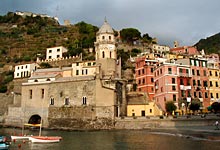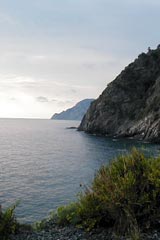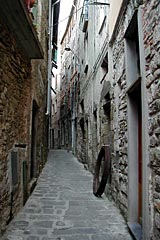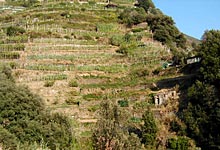Cinque Terre … beyond the Riviera

Vernazza Port
Cinque Terre is a small region along the northwestern Italian coast just below Porto Fino. The coastal region from San Remo to Porto Fino is considered the Italian Riviera and is popular with high rollers at the well-known casinos and topless beach bunnies on unlimited credit card accounts. But just to the south the coastline changes from mostly beachy to rugged mountainous terrain. There the five towns located in a row along the sea give the region it’s name, “Five Lands.”
Special Note: The Cinque Terre region, Vernazza and Monte Rosso in particular, were heavily damaged by a storm in October of 2011 where a great amount of rain fell in a short period of time. This generated floods and mudslides into and through these towns as well as the surrounding region. Cinque Terre is too beautiful and much too loved by residents and visitors alike to remain devastated. Much effort has been expended to its restoration!
All of the five towns of the Cinque Terre region are beautiful and generally unspoiled by progress. Due to the challenging terrain it was actually a bit difficult to reach this area until fairly recently and roads leading from one town to another still need to wind their way up into the hills in order to again wind down to the next town. There is a train line that runs through long tunnels near the sea but there is no road that follows the coastline between the towns … except for the ancient footpaths that make for great walking and hiking.

Cinque Terre Coastline
Germans, British, Canadians, Australians, French and Americans are very fond of this region and it is quite busy in the peak season of mid-summer. But it is also much less busy in the off-season and the mild climate can still provide good weather for swimming and hiking. We visited Cinque Terre in early September and found the quantity of tourists to be manageable though a few of the locals seemed a bit burned out from the summer traffic (put yourself in their place … tourists can be very unpleasant and demanding).
We made a great decision, quite by accident, when deciding which of the five towns of the region to rent an apartment in. We chose the town in the middle, Corniglia, because we thought it would allow us to walk in either direction to the other towns and frankly we just liked the looks of the little town that sits up high on a rocky prominence. We didn’t know that our decision would also yield the quietest evenings with few tourists and a great view of the town and sea right from our apartment’s patio.

Corniglia Street View
Transportation in Cinque Terre is very interesting and quite a bit of fun. First and foremost you have your feet. Walking the ancient paths from town to town is the best way to experience the area and the views approaching and departing the towns are spectacular. Then there is the train, which runs along the coast, mostly hidden within tunnels joining the towns. You can buy a pass for a week and use it to come back to “your town” after a long day of walking or to get to another town for dinner and a night out. Then there are boats, that connect four of the towns with regular daytime service.
Corniglia is the one town without a calm harbor and the boats do not stop there. Last, there are roads that wind their way up into the hills and back down to the different towns but most of the towns do not have streets for cars, just for walking, so you need to park wherever space is provided for and walk from there anyway. In general we recommend going to Cinque Terre by train, regardless of which town you might choose to stay in. Having a car would not be a tremendous asset, rather a bit of a nuisance.

The vineyard terraces




